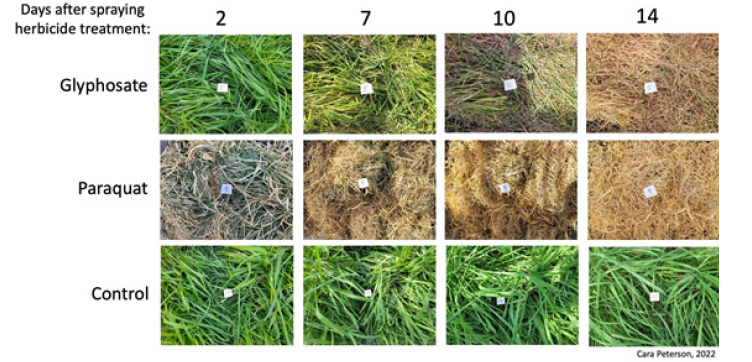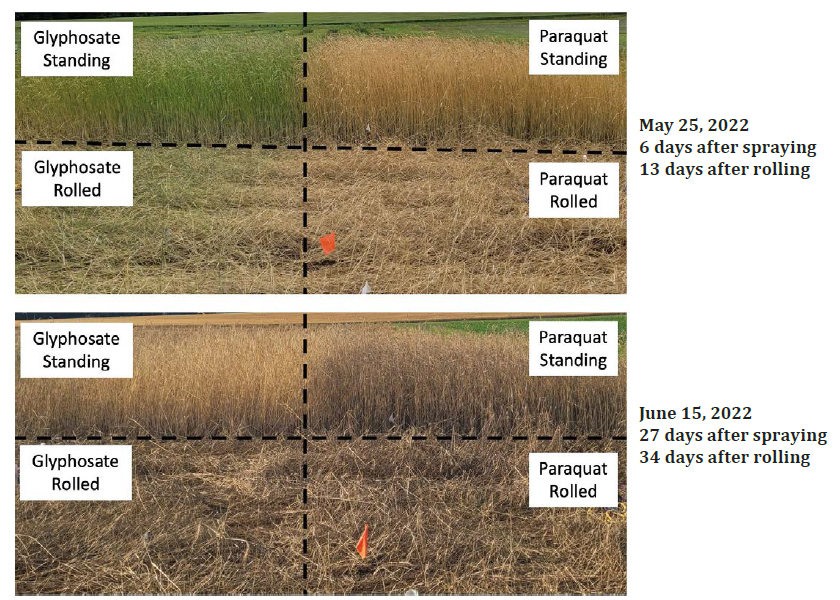Impact of Cover Crop Termination Method on Soil Moisture
CMREC – Beltsville Field Experiment
Cara Peterson, PhD Candidate, Dr. Kate Tully, Associate Professor, Agroecology Lab, Department of Plant Sciences and Landscape Architecture
Dr. Steven Mirsky, Research Ecologist, Sustainable Agricultural Systems Laboratory, Agricultural Research Service, USDA
To prepare for spring planting, farmers rely on mechanical (e.g., roller-crimping, mowing, tilling) and chemical methods to terminate their winter cover covers. Most growers using cover crops in conventional grain production systems terminate their cover crops in the spring by spraying broad spectrum post-emergent herbicides. Additionally, farmers in both conventional and organic production systems might roller-crimp their winter cover crop, effectively flattening the cover crop biomass into a mulch layer. Recent research has focused on herbicide selection and roller-crimper timing for effective cover crop termination, however there is limited knowledge about the impact of these choices on spring soil moisture dynamics and cover crop residue decomposition.
Herbicide selection, specifically the choice between a contact and systemic product, could lead to differences in the plant senescence, evapotranspiration, and decomposition rates of the living and dead cover crop. The application of a systemic herbicide, such as glyphosate, results in a gradual senescence of the plant tissue and maintenance of the plant structure, meaning transpiration through the plant could potentially continue for a sufficient time after cover crop termination to result in drier soil moisture levels than a similar field of cover crops sprayed with a faster-acting herbicide. In contrast, rapid disintegration of plant cell membranes and the ensuing loss of plant structure after exposure to a contact herbicide may lead to a quick decline in cover crop water uptake, although this has not yet been documented in the scientific literature. Regarding mechanical termination, flattening cover crops with a roller-crimper reduces evapotranspiration and conserves soil moisture. Expedited contact with the moist soil surface and microbes after roller-crimping will hasten tissue decomposition and nutrient release compared to cover crop residue that remains upright.
A field study is underway to quantify the cover crop evapotranspiration, and decomposition rates of a cereal rye (Secale cereale L.) cover crop terminated with a systemic herbicide (glyphosate) versus a contact herbicide (paraquat), with an additional roller-crimper treatment. With increasing variability in spring precipitation due to climate change, optimizing these cover crop termination methods for both dry and wet conditions is essential to increasing agroecosystem resiliency.

Image 1: Cereal rye cover crop plots, May 12, 2022, immediately after roller-crimping treatments.
Experimental design
Experimental plots were established in both 2022 and 2023 at the CMREC-Beltsville facility. The two field sites are on very sandy and well-drained soil, and the experiment is simultaneously being executed at sites with heavier, slower-draining soils at the USDA BARC facility nearby. When the cereal rye winter cover crop reached anthesis, the optimal growth stage for termination by roller-crimping, half of the cover crop plots were rolled. One week later, the cereal rye plots were sprayed with the two herbicide treatments in perpendicular direction to the roller-crimper path to achieve four termination treatments: Rolled + Paraquat; Standing + Paraquat; Rolled + Glyphosate; and Standing + Glyphosate. Two control treatments without a cover crop were also established: bare fallow and straw mulch.
Time domain reflectometry (TDR) sensors were installed at surface level, 10 in., 20 in., and 30 in. depths to continuously measure and record soil moisture and temperature. To quantify cover crop decomposition, a litterbag study was also included in the experiment. In residue decomposition studies, the cover crop biomass substrate is typically collected at termination, however that would negate the termination treatments put in place in this experiment. Therefore, the biomass substrate material was collected two weeks after the herbicide treatments were sprayed. The litterbags were then placed back in the field plots and moved to a nearby corn field after fertilizer side-dressing had occurred in order to provide realistic conditions for cover crop residue during the remainder of the production season.

Image 2: Test plots of cereal rye sprayed with glyphosate and paraquat, shown alongside a control treatment, demonstrating the different efficacy rates of the two herbicides.
Preliminary results
While data collection and analysis are still underway for the 2023 field study, there are some preliminary observations from the 2022 season. With very heavy rainfall throughout the 2022 experimental period, soil moisture levels were relatively similar across the termination treatment plots. At the CMREC-Beltsville location with sandy soil, any rainfall drained away so quickly that no treatment differences in soil moisture emerged. The field site at USDA-BARC drained very slowly, and soil moisture remained high throughout the spring. During some dry-down periods, a slight effect of mechanical termination could be seen, with the roller-crimped plots remaining wetter than the plots where the cover crop residues remained standing. This year’s drier spring with minimal precipitation will likely draw out any differences in soil moisture among treatments if they exist, with the roller-crimper plots likely to reduce evaporation during the dry periods.

Image 3: Termination method treatments in cereal rye cover crop plots at CMREC-Beltsville.
 Results from the 2022 residue decomposition study component demonstrated no differences in decomposition rates among the termination treatments. This could likely be a result of terminating the cereal rye cover crop at a later growth stage in order to accommodate the roller-crimper treatment. As cereal rye matures, the carbon to nitrogen ratio of the plant tissue residue decreases, which slows the residue decomposition in comparison to cereal rye terminated at earlier growth stages.
Results from the 2022 residue decomposition study component demonstrated no differences in decomposition rates among the termination treatments. This could likely be a result of terminating the cereal rye cover crop at a later growth stage in order to accommodate the roller-crimper treatment. As cereal rye matures, the carbon to nitrogen ratio of the plant tissue residue decreases, which slows the residue decomposition in comparison to cereal rye terminated at earlier growth stages.
At this time, soil moisture and biomass decomposition data collection are underway for the 2023 field experiment and we look forward to sharing our final experimental results when the study has concluded.
Image 4: Cereal rye biomass in litterbags for biomass decomposition component of field study. At set times throughout the season, one litterbag is collected from each treatment and replicate group to assess biomass loss over time. Cara Peterson, 2022.
Back to Roots in Research - Beltsville